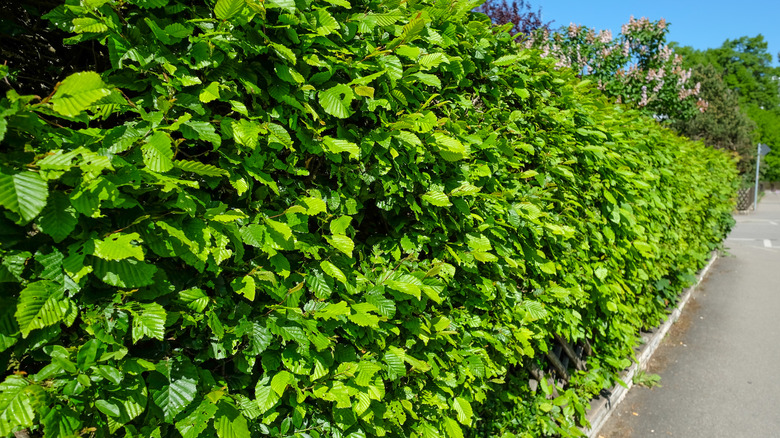Meet The Stunning Birch-Tree Cousin In Martha Stewart's Hedge Maze
We may receive a commission on purchases made from links.
In addition to lending shade and visual appeal to your yard, a healthy green hedge can make it feel more secluded. In most cases, the best plants for privacy hedges are easy to maintain and well-suited to your USDA hardiness zone. One of Martha Stewart's recommendations for a lush privacy hedge is the European hornbeam (Carpinus betulus), a deciduous tree that thrives in zones 4 through 8. Like its birch-tree cousins, it produces catkins that flower early in the spring, before its leaves sprout. Though European hornbeams can be grown as single trees, their thick foliage makes them an ideal choice for privacy hedges and topiaries.
Stewart recently added a European hornbeam hedge to her farm's "living maze," a landscape she mentions frequently on The Martha Blog. In a post about this project, she said she loves how these trees grow quickly and "provide changing texture and color during the year — green foliage in summer, golden yellow leaves in fall, and natural gray bare branches in winter." The fluted trunks, which resemble muscle fibers, are especially attractive, as are the grooved and serrated leaves, which resemble those of the common beech (Fagus sylvatica).
When creating hornbeam hedges, Stewart's team starts with bare-root cuttings. The dormant trees sit in containers of water until the planting site is ready. Other preparations include stripping sod, tilling and fertilizing the soil, and digging holes for the plants. Each hole should be at least twice as wide as the plant's cluster of roots. Taut twine ensures that the plants are positioned in a straight line. The next step of the process involves planning and pruning.
How to make a privacy hedge from European hornbeams
For maximum privacy, plant your European hornbeams in a sunny spot. This encourages the densest foliage. If super-thick foliage isn't your goal, you can grow these hornbeam trees in a shady yard, though most varieties prefer part shade over dense shade. When determining your hedge's dimensions, keep in mind that this species typically grows to a height of 40 to 60 feet. Since a privacy hedge is essentially a wall of foliage, you'll need to convince your hornbeams to grow in this shape. Grab a sharp, clean clipper for this task. A Fiskars 23-inch hedge shear is a solid choice for branch removal. You may also want a smaller tool for stems, such as pruning shears. Or consider a power tool such as a cordless Greenworks 22-inch rotating handle hedge trimmer, which comes with a battery and charger. While you're out, pick up stakes and string to mark off the area your plants should stay within.
New hedge plants need annual formative pruning to promote growth and help them assume the shape you're seeking. As your hedge matures, it will also require maintenance trimming to help it stay healthy and maintain its shape. Since European hornbeams have spring and fall growth spurts, many gardeners prune after each to keep their plants looking neat. If you only trim your hornbeams once a year, do it in the spring, following the first spurt. Lop off larger branches first and make your tree wall widest near the ground, which aids sunlight distribution. This can keep your trees from becoming leggy. With a little practice, you'll be pruning your trees like a pro.

